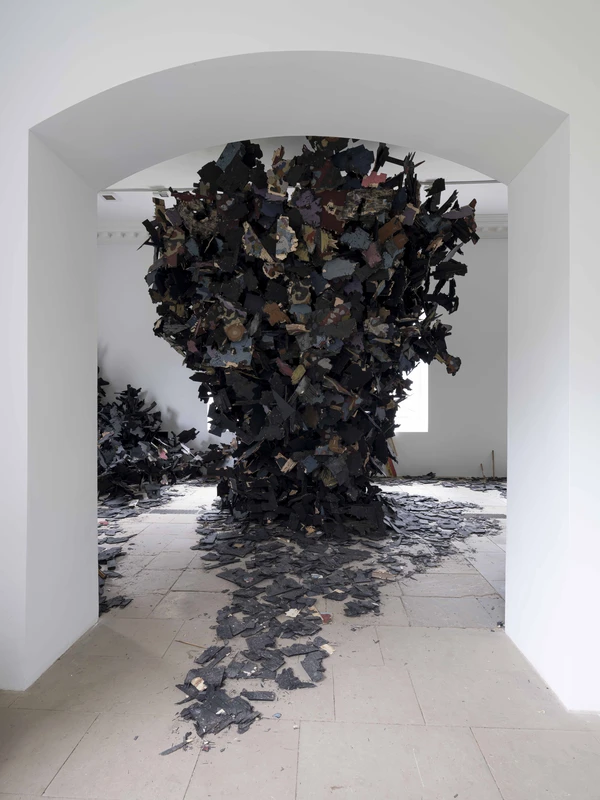Leonardo Drew
18 Mar-29 Oct 2023


Living and working in Brooklyn, New York, Leonardo Drew’s abstract works, made from an outpouring of chaotic elements, create installations that express immense tension and turbulence. The artist’s new work, Number 360 (2023), commissioned for YSP’s 18th-century Chapel, is a powerful reflection on the weight of collective experience, memory, and the cycles of life and death, decay and regeneration. This resonates within a historic building where many lives have been played out for centuries – unknown to us, yet somehow conveyed by the atmosphere of the space.
Drew joins several artists in responding to the Chapel, which was built in 1740 and is a singular, contemplative place. Projects here set out to connect emotionally with a wide humanity and to be welcoming to everyone. Previous artists include Ai Weiwei, James Lee Byars, Kimsooja, Rachel Kneebone, Shirin Neshat, Yinka Shonibare, Chiharu Shiota and Bill Viola.
The basic material of Number 360 is plywood, either blackened or covered with textured coloured paint, which has been ripped apart and splintered to form the building blocks of a conical monolith that surges to over five metres in height. Unusually for Drew, Number 360 is a vertical installation, responding to the height and width of the chapel nave.
Like an explosion held in time, Number 360 conveys ferocious energy as well as trauma and rupture. Drew’s fractured surfaces create their own language, embodying the laboured process of writing the artist’s experience into history. An African American artist born in Tallahassee in 1961 and raised in public housing in Bridgeport, Connecticut, Drew has often alluded to socio-political issues in his work, using such symbolically charged materials as cotton, rope, rags and rust that relate to the antebellum South, the African American experience, and America’s industrial past. He is, however, adamant in his resistance to impose explicit meaning, and chooses to title his pieces only with numbers in order, “to give the viewer enough room to find themselves in the work”.
In his youth, Drew excelled in draughtsmanship yet gave it up so that he could discover his own, true visual voice. Although both Marvel and DC comics were interested to recruit the young artist, by this time he had come across the work of Jackson Pollock and the impact was sufficient to compel him into taking a radically different path. In 1982, he stopped drawing and painting to remove the possibility of reverting to the habitual, and to allow himself to forge ahead with unfamiliar materials. Drew began working with the bones and skins of dead animals: the matter and remnants of death held so much residual potency and poetry as materials that they set the tone for all that was to follow. His seminal Number 8(1988), which he describes as ‘the mother’, steered his practice. Featuring an abundance of objects held within a dense mass of black rope – detritus, wood, birds’ wings, skulls, animal hides – it is emotionally heavy and black as though weathered by experience itself. The overpowering sense of writhing decay, of an inevitable process in temporary stasis, undoubtedly feeds into Number 360. Although the materials have changed, that same pervasive language remains.
Drew is driven by relentless curiosity, which he feeds through travel. From 2015, for four years, he made numerous visits to Jingdezhen in China, known for over 1,700 years for porcelain production, where he was fascinated by the ‘alchemy’ of the making process. Inspired by, but also working against the tight parameters of the tradition, he experimented with abstracting from conventional ceramic forms by smashing them into fragments and firing them together to see how the pieces fused in the kiln. These shattered pieces informed his work in other materials and directly contributed to the treatment of the plywood seen in Number 360. Critically, through his experience of ceramic glazing, surface design and working with different types of clay and earth in Jingdezhen, colour began to seep into Drew’s previously largely monochrome work. In Number 360, the coloured elements are covered with acrylic paint mixed with sand to give a rough, dry texture. Persian rugs provide the visual origins for the work’s colour palette and its painted patterns.
Often Drew repurposes material from previous pieces to make new ones and much of the wood for Number 360 at YSP comes from Number 341 (2022) made for Art Basel: Unlimited in Switzerland. There is an overwhelming sense of accumulation and revisiting in the way he works, of avid collecting and recycling, both through lived experiences and the tactile experience of materials.
“Leonardo Drew’s new work will have an incredibly impactful presence in YSP’s Chapel, creating a magnetic relationship between the meditative character of the space and the emotionally charged nature of the piece. This intensity and poignancy of the installation will resonate deeply with the often troubled times in which we live.”
- Sarah Coulson, Senior Curator at Yorkshire Sculpture Park